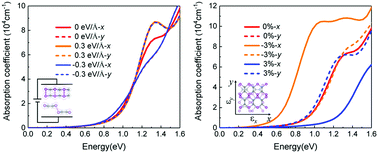Highly tunable electronic structure and linear dichroism in 90° twisted α-phosphorus carbide bilayer: a first-principles calculation†
Abstract
α-Phosphorus carbide (α-PC) shares a similar puckered structure with black phosphorus and has a high carrier mobility, showing great application potential in the future nano-electronic devices. Based on first-principles calculations, we reveal that an interlayer twist angle of 90° results in a symmetric band dispersion and spatial separation of electronic states in the α-PC bilayer, leading to isotropic electrical transport. Nevertheless, the anisotropic electronic states can be rebooted by introducing an out-of-plane electrostatic potential or an in-plane deformation potential, both of which can break the energy degeneracy and continuously modulate the bandgap of the 90° twisted bilayer. This highly tunable band structure can also induce a directionally exchangeable optical linear dichroism by flipping the voltage sign or changing the strain mode. These results indicate that the combination of the interlayer twist and gating/strain technique provides great flexibility to control the anisotropic behaviors in 2D puckered materials.

- This article is part of the themed collection: 2021 PCCP HOT Articles


 Please wait while we load your content...
Please wait while we load your content...